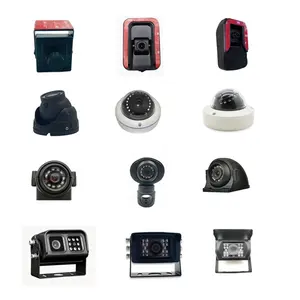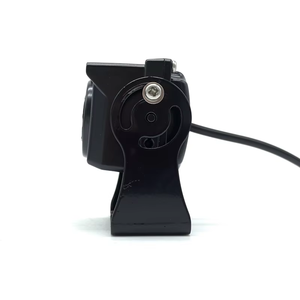(18486 products available)



































































































































































































































Truck backup cameras come in various types, and some of them include the following.
This is the most basic type of truck backup camera system. This camera is mounted at the back of the truck and offers a direct view behind the truck. They possess a narrow field of view and lack advanced features, making them affordable and simple. These cameras are suitable for smaller trucks.
These cameras are mounted on both the rear and front of the truck, allowing drivers to see what is behind and in front of the truck. This camera system offers a more comprehensive view, enabling drivers to maneuver the truck in any direction.
These types of cameras are suitable for larger trucks. They provide an all-round view of the truck, allowing the driver to see all sides of the truck. This camera system is made up of several cameras mounted on the truck, which are then integrated to create a 360-degree view. This makes parking and maneuvering the truck easier and safer.
These truck backup cameras are equipped with night vision technology, which enables the camera to provide clear images in low light and dark environments. This feature is essential for trucks that travel at night or in poorly lit areas.
These cameras are easy to install and do not require wire connections. They use wireless signals to transmit images from the camera to the monitor. This feature eliminates the need to run cables from the front to the back of the truck, reducing installation time.
Truck owners can also purchase cameras with additional features, such as distance lines, which show the distance between obstacles and trucks. They can also buy cameras with alerts that alert the driver to obstacles using audio or visual signals. Some cameras have the ability to record videos, which is useful in the event of an accident.
Every reverse camera system has its features, specifications, and maintenance requirements. Here are the specifications of different types of rear backup camera for truck systems.
These cameras have a resolution of 300,000 to 600,000 pixels. They provide a clear image, although not high definition. The field of view ranges from 100 to 120 degrees, allowing the driver to see the space behind the vehicle. Some cameras have a wider viewing angle, which helps the driver see the entire surrounding. The cameras have a night vision feature, which uses LED lights to provide a clear image in the dark. The LED lights often have a range of 15 to 50 feet. When it is pitch black, the driver can only see obstacles close to the vehicle. The cameras are waterproof.
The camera monitor is 3.5 to 7 inches. It is large enough to see the space behind the truck. It is also small enough to fit in the cab without obstructing the driver's view. The image quality of the monitor is good. The driver can see objects clearly. However, the monitor does not provide the high definition of advanced models.
These wired backup cameras are durable and can withstand harsh weather. When they are damaged, they are easy to replace. Users should set a maintenance schedule so they can inspect the cameras regularly. They should inspect the lenses for dirt and the wiring for damage. The cameras should also be cleaned regularly, and the software should be updated if necessary.
The resolution of wireless backup cameras is 480,000 to 800,000 pixels. Some high-end models have 2 million pixels. They have a viewing angle of 120 to 150 degrees, allowing drivers to see their environment. The cameras have night vision features, which allow drivers to see in the dark. The night vision feature has a range of 15 to 50 feet. The cameras are waterproof, which makes them suitable for different weather conditions.
Wireless cameras have monitors that are 4.3 to 7 inches. The monitor provides clear images, but it doesn't support high-definition images. Maintaining wireless backup cameras for pickups is easy. Users should clean the camera and monitor regularly. They should also check for software updates and inspect the cameras for damage.
The resolution of the DVR backup camera is 720p. It provides a clear image and allows the driver to see details. The viewing angle is 120 to 170 degrees. It allows the drivers to see their environment. The cameras have night vision capabilities, which allows drivers to see in the dark. The cameras have a night vision range of 15 to 50 feet. The cameras are also waterproof, which enables them to work in different weather conditions.
These cameras have a high resolution of 1080p and 720p. They provide a clear image, and the driver can see details. The monitor is 4.3 to 7 inches. It allows the driver to see the space behind the truck. The monitor also supports high-definition images.
Maintaining DVR backup cameras is easy. Users should clean the camera and monitor regularly. They should also check for software updates and inspect the cameras for damage.
When choosing a truck backup camera, business buyers can consider the following:
Buyers should consider getting camera systems with good resolution and image quality. This makes it easy to see details and obstacles when reversing the truck.
They should consider getting a backup camera with a wide-angle to capture a larger area behind the truck. This helps in detecting obstacles on the sides.
Different camera types work well in various situations. For instance, a low light camera system is suitable for use during the night or in dark areas.
Wired systems offer a stable connection but are complicated to install. On the other hand, wireless systems are easy to install and have interference problems.
Business buyers should choose a backup camera that is waterproof and can withstand harsh weather conditions to ensure durability.
They should consider how easy the camera system is to install. It is important to get a rear camera for truck that comes with a manual guide for easy installation.
These could be features such as night vision, adjustable guidelines, motion detection, and automatic activation that improve the performance of the rear view cameras for trucks.
They should ensure the camera is compatible with the truck's model and other devices that are connected to it.
Here are the steps for a DIY truck backup camera installation.
Q1: What is the difference between 1 camera and 2, 3, 4, 5, or 6 cameras for a truck?
A1: A single camera is mounted on the rear of the truck. It offers a view directly behind the vehicle. Two cameras are installed on the back and front of the truck. Drivers can view both the front and back of the truck simultaneously. Three cameras are placed on the front, back, and one side of the truck. They give the ability to see around the truck. Four cameras are set up in front, back, and both sides. They provide 360-degree visibility around the truck. Five and six cameras offer all the features of four cameras plus additional views in front or back of the truck.
Q2: Do all backup cameras need a battery?
A2: No, not all truck backup cameras need a battery. Wired cameras use a power supply from the truck. Mostly, battery-operated backup cameras have a simple installation. They are portable and do not require any wiring.
Q3: Can a backup camera be installed in any truck?
A3: Yes, all backup camera kits can be installed in any truck. The installation is easy and includes instructions from the manufacturer. It may require additional mounting hardware.
Q4: How long does a truck backup camera last?
A4: The backup camera can last from 5 to 10 years, depending on frequent use and quality of the camera. Repeated use can reduce the lifespan of the rear backup camera for truck.
Q5: What is the difference between wired and wireless backup cameras?
A5: Truck wired backup cameras have a long-lasting system and provide a stable connection. They are not easily disrupted by wireless signals. They are hard to install, and they are more expensive than wireless backup cameras. Truck wireless backup cameras provide an easy and quick installation. They are affordable and can be transferred to another vehicle. The signal can be disrupted by wireless devices such as Bluetooth and Wi-Fi. They do not offer a stable connection compared to wired backup cameras.